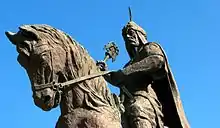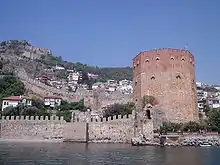Kayqubad I
Kayqubad I or Alā ad-Dīn Kayqubād bin Kaykhusraw (Persian: علاء الدين كيقباد بن كيخسرو; Turkish: I. Alâeddin Keykûbad, 1190–1237) was the Seljuq Sultan of Rûm who reigned from 1220 to 1237.[1] He expanded the borders of the sultanate at the expense of his neighbors, particularly the Mengujek Beylik and the Ayyubids, and established a Seljuq presence on the Mediterranean with his acquisition of the port of Kalon Oros, later renamed Ala'iyya in his honor. The sultan, sometimes styled "Kayqubad the Great",[2] is remembered today for his rich architectural legacy and the brilliant court culture that flourished under his reign.
| Sultan Aladdin Kayqubad I | |||||
|---|---|---|---|---|---|
 Statue of Kaykubad I in Alanya | |||||
| Seljuq sultans of Rum | |||||
| Reign | 1220–1237 | ||||
| Predecessor | Kaykaus I | ||||
| Successor | Kaykhusraw II | ||||
| Born | 1190 Konya | ||||
| Died | 1237 (aged 46–47) Kayseri | ||||
| Burial | |||||
| Consort | Mahpari Hunat Khatun Malika Adila Khatun Ismat al-dunya wa'l-din | ||||
| Issue | Gıyaseddin Kaykhusraw II Rukn al-Din Kiliç Arsalan Izz al-Din Kaykaus | ||||
| |||||
| House | House of Seljuq | ||||
| Father | Kaykhusraw I | ||||
| Mother | Raziya Khatun | ||||
| Religion | Islam | ||||
Kayqubad's reign represented the apogee of Seljuq power and influence in Anatolia, and Kayqubad himself was considered the most illustrious prince of the dynasty. In the period following the mid-13th century Mongol invasion, inhabitants of Anatolia frequently looked back on his reign as a golden age, while the new rulers of the Anatolian beyliks sought to justify their own authority through pedigrees traced to him.
Biography

Kayqubad was the second son of Sultan Kaykhusraw I, who bestowed upon him at an early age the title malik and the governorship of the important central Anatolian town of Tokat. When the sultan died following the battle of Alaşehir in 1211,[3] both Kayqubad and his elder brother Kaykaus struggled for the throne. Kayqubad initially garnered some allies among the neighbors of the sultanate: Leo I, the king of Cilician Armenia and Tughrilshah, the brothers' uncle and the independent ruler of Erzurum. Most of the emirs, as the powerful landed aristocracy of the sultanate, supported Kaykaus. Kayqubad was forced to flee to the fortress at Ankara, where he sought aid from the Turkman tribes of Kastamonu. He was soon apprehended and imprisoned by his brother in a fortress in western Anatolia.[4]
Upon Kaykaus' unexpected death in 1219 (or 1220), Kayqubad, released from captivity, succeeded to the throne of the sultanate.

In 1227/1228, Kayqubad advanced into Anatolia, where the arrival of Jalal ad-Din Mingburnu, who was fleeing the destruction of his Khwarezmian Empire by the Mongols, had created an unstable political situation. The sultan settled Turcomans along the Taurus Mountains frontier, in a region later called İçel. At the end of the 13th century, these Turcomans established the Karamanids. The sultan defeated the Artuqids and the Ayyubids and absorbed the Mengujek emirate into the sultanate, capturing the fortresses of Hısn Mansur, Kahta, and Çemişgezek along his march. He also put down a revolt by the Empire of Trebizond and, although he fell short of capturing their capital, forced the Komnenos dynasty family to renew their pledges of vassalage.
At first Kayqubad sought an alliance with his Turkish kinsman Jalal ad-Din Mingburnu against the Mongol threat. The alliance could not be achieved, and afterwards Jalal ad-Din took the important fortress at Ahlat. Kayqubad finally defeated him at the Battle of Yassıçimen between Sivas and Erzincan in 1230. After his victory, he advanced further east, establishing Seljuq rule over Erzurum, Ahlat and the region of Lake Van (formerly part of Ayyubids). The Artuqids of Diyarbakır and the Ayyubids of Syria recognized his sovereignty. He also captured a number of fortresses in Georgia, whose queen sued for peace and gave her daughter Tamar in marriage to Kayqubad's son, Kaykhusraw II.[5]
Mindful of the increasing presence and power of the Mongols on the borders of the Sultanate of Rum, he strengthened the defenses and fortresses in his eastern provinces. He was given poison during a feast at Kayseri[6] and died at an early age on 31 May 1237, the last of his line to die in independence.[7]
Historian Ibn Bibi mourned his death with these words,"With Kayqubad's death, the back of Islam was broken and the bond of kingdom and religion snapped".[8]

Succession
Kayqubad had three sons: Kaykhusraw II, eldest and son of his Greek wife Mah Pari Khatun,[9] and, Rukn al-Din and Kilic Arslan, sons of his Ayyubid princess wife Malika Adila Khatun.[10] According to Ibn Bibi, Kayqubad wanted Rukn al-Din as his successor who was elder one of his two sons from his Ayyubid wife, Malika Adila Khatun, but Kaykhusraw usurped the throne and had Rukn al-Din, Kilic Arslan and their mother strangled.[11][12]
Architectural and cultural legacy
Kayqubad sponsored a large scale building campaign across Anatolia. Apart from reconstructing towns and fortresses, he built many mosques, medreses, caravanserais, bridges and hospitals, many of which are preserved to this day. Besides completing the construction of the Seljuq Palace in Konya, he also built the Kubadabad Palace on the shore of Lake Beyşehir,[13] Alanya Castle and Red Tower in Alanya and Kayqubadiyya Palace near Kayseri.[2]
Kayqubad, like the other Seljuq sultans of Rum, was quite well versed in the fine arts and would recite quatrains in Persian during wine drinking parties.[14]
Identity
According to Rustam Shukurov, it is very probably that Kayqubad and his brother Kaykaus I, who both spent considerable time in Byzantium with their father, had the same dual confessional (Christian and Muslim) and dual ethnic (Turkic/Persian and Greek) identity as Kaykhusraw I, Kaykaus II, and Mesud II.[15]
Relations with Scholars
Kayqubad I had good relations with the Muslim scholars, sufis and poets. Many Muslim sufis and poets such as Mūhyūddīn İbnūl-Arābī, Abd al-Laṭīf al-Baghdādī, Ahi Evran, Necmeddīn-i Dāyē, Kāniî-i Tūsī, Shihab al-Din 'Umar al-Suhrawardi and Sultanulūlemā Bâhâeddīn Veled came to Anatolia during his reign.
Portrayal in Media
In the Turkish historical television series, Diriliş: Ertuğrul, Kayqubad I is portrayed by Turkish Actor Burak Hakkı.
References
- Cahen 1997, p. 817-818.
- Lambton & Lewis 1977, p. 248.
- Redford 1991, p. 70.
- Cahen 1968, p. 120-121.
- Cahen 1968, p. 130.
- Savvides 1981, p. 190.
- Wolff & Hazard 1969, p. 704.
- Anooshahr 2008, p. 116.
- Peacock & Yildiz 2013, pp. 118-119, 121.
- Cahen 1968, p. 133.
- Eastmond 2017, p. 197.
- Cahen 1997a, p. 811.
- Redford 1993, p. 220.
- Koprulu 2006, p. 220.
- Peacock & Yildiz 2013, p. 133.
Sources
- Anooshahr, Ali (2008). The Ghazi Sultans and the Frontiers of Islam: A comparative study of the late medieval and early modern periods. Routledge. ISBN 978-11-34-04134-3. Retrieved 19 August 2020.
- Lambton, Ann K.S.; Lewis, Bernard (1977). The Cambridge History of Islam: The Central Islamic lands since 1918. Vol. 1B. Cambridge University Press. p. 248. ISBN 978-052-129-135-4. Retrieved 19 August 2020.
- Cahen, Claude (1968). Pre-Ottoman Turkey: A general survey of the material and spiritual culture and history c. 1071-1330. New York: Taplinger. hdl:2027/heb.00871. ISBN 1-59740-456-X.
- Cahen, Claude (1997). "Kaykubad; Kaykubad I". In Van Donzel, E.; Lewis, B.; Pellat, Ch. (eds.). The Encyclopaedia of Islam. IV. Brill. p. 817-818.
- Cahen, Claude (1997a). "Kaykhusraw; Kaykhusraw II". In Van Donzel, E.; Lewis, B.; Pellat, Ch. (eds.). The Encyclopaedia of Islam. IV. Brill. p. 816-817.
- Crane, H. (1993). "Notes on Saldjūq Architectural Patronage in Thirteenth Century Anatolia". Journal of the Economic and Social History of the Orient. Leiden: Brill. 36 (1): 1–57. doi:10.1163/156852093X00010. ISSN 0022-4995. JSTOR 3632470.
- Eastmond, Antony (2017). Tamta's World. Cambridge University Press. p. 197. ISBN 978-11-07-16756-8. Retrieved 15 August 2020.
- Koprulu, M. (2006). Early Mystics in Turkish Literature. Translated by Leiser, Gary; Dankoff, Robert. Routledge.
- Peacock, A. C. S. (2006). "The Saljūq Campaign against the Crimea and the Expansionist Policy of the Early Reign of 'Alā' al-Dīn Kayqubād". Journal of the Royal Asiatic Society. Cambridge: Cambridge University Press. 16 (2): 133–149. doi:10.1017/S1356186306005979. ISSN 1356-1863.
- Peacock, A.C.S.; Yildiz, Sara Nur, eds. (2013). The Seljuks of Anatolia: Court and Society in the Medieval Middle East. I.B.Tauris. ISBN 978-0857733467.
- Redford, Scott (1991). "The Alaeddin Mosque in Konya Reconsidered". Artibus Asiae. Zürich: Artibus Asiae Publishers. 51 (1/2): 54–74. doi:10.2307/3249676. ISSN 0004-3648. JSTOR 3249676.
- Redford, Scott (1993). "Thirteenth-Century Rum Seljuq Palaces and Palace Imagery". Ars Orientalis. Vol. 23, Pre-Modern Islamic Palaces.
- Savvides, A.G.C. (1981). Byzantium in the Near East: Its Relations with the Seljuk Sultanate of Rum in Asia Minor, the Armenians of Cilicia and the Mongols, A.D. C. 1192-1237, Volume 16. Kentron Vyzantinōn Ereunōn - Original from University of Michigan. p. 190. Retrieved 15 August 2020.
- Wolff, R.L.; Hazard, H. W., eds. (1969). The Later Crusades, 1189-1311 — XX: The Aiyubids. University of Wisconsin Press. p. 693-714.
External links
| Wikimedia Commons has media related to Kayqubad I. |
| Preceded by Kaykaus I |
Sultan of Rûm 1220–1237 |
Succeeded by Kaykhusraw II |